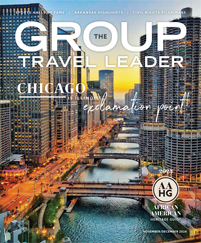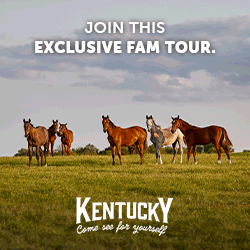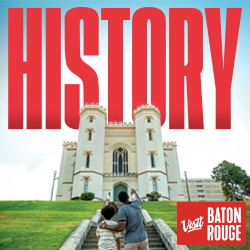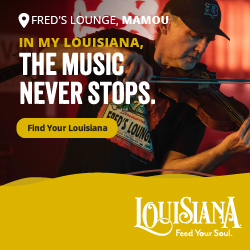Some of America’s most iconic travel photos have been taken on Route 66.
The Mother Road is known for its crazy roadside attractions, relics left behind from long ago when families would hop in their vehicles and drive across country for vacations. Locals would build monuments to advertise their towns or businesses along the road, and even though the businesses no longer exist, their monuments live on and draw visitors from all over.
Here are a few favorites from Route 66 that are totally Instagram-worthy.
Bunyon Giant
Atlanta, Illinois
In Atlanta, Illinois, Bunyon Giant was one of the original Muffler Men used to advertise businesses along Route 66. This particular Muffler Man is is made from fiberglass, polyester resin and steel, and stands 19 feet tall. Instead of a muffler, he holds a giant hot dog in his hands to advertise a now-defunct hot dog restaurant in Cicero, Illinois. When the family that owned the restaurant decided to close down, they thought about selling the statue but decided to donate it to a community along Route 66 instead.
The giant arrived in Atlanta in 2003 and has not left since.
“For community members, he is a town icon,” said Whitney Ortiz, tourism director for Atlanta. “Everyone knows and loves the giant.”
Residents of the town are proud to have the giant because of his status along Route 66. Before the pandemic hit, the town had about 10,000 visitors a year, about 75% of whom came just to snap photos of the famous statue, with his red shirt, blue pants and serious expression. International visitors love the Bunyon Giant. The town even hosted a radio broadcast from a Czech radio station in front of the statue because of its iconic status among international tourists, Ortiz said.
Nearby, visitors can stop in Route 66 Park to take a sip out of the bubbler fountain or visit the U.S. Route 66/Illinois Route 4 Driving Exhibit, which is located on the north edge of Atlanta and features a quarter-mile section of concrete roadbed constructed in 1924 when Illinois Route 4 became the first paved road in Logan County. The road’s name changed to Route 66 in 1926 when it became part of the new U.S. Highway System. The section of road was abandoned after World War II when a Route 66 bypass was installed around Atlanta.
Standing on the Corner Park
Winslow, Arizona
One of the most famous photo ops on Route 66 in Winslow, Arizona, Standing on the Corner Park features a two-story, Trompe-l’œil mural by John Pugh that gives the illusion of being three-dimensional. It is accompanied by “Easy,” a life-size bronze statue of a man holding a guitar, created by Ron Adamson. It was inspired by the American troubadours of the 1970s. The mural depicts a girl driving a flatbed Ford and represents famous lyrics from The Eagles’ first hit single, “Take it Easy.” The song’s famous lyrics mention a flatbed Ford on a corner in Winslow, Arizona. Parked on the corner is a red flatbed Ford that looks identical to the one in the mural.
Visitors come from all across the country and from around the world to stand on the corner of Kinsley and East Second Street and snap photos of the mural and statue. Winslow, like many towns along Route 66, faded into the background when Interstate 40 bypassed it. On May 29, 1997, the Standin’ on the Corner Foundation decided to develop a park in downtown Winslow commemorating the Eagles song that put Winslow back on the map. The park was dedicated in 1999. After Eagles founding member Glenn Frey passed away in 2016, the foundation commissioned another statue in his memory.
Visitors to Winslow will also want to stop at the Old Trails Museum, which tells the history of the area with exhibits on topics such as the Hopi and Navajo people, the Mormon’s Brigham City, the Santa Fe Railway, area ranches and trading posts, Fred Harvey and La Posada Hotel.
Blue Whale of Catoosa
Catoosa, Oklahoma
The Blue Whale in Catoosa, Oklahoma, is one of the most iconic attractions along Route 66. It is strategically located just outside of Tulsa and is hard to miss when traveling on Route 66 east to west.
But it wasn’t originally intended for the public. Hugh Davis built the Blue Whale in the early 1970s as a surprise anniversary gift for his wife, Zelta, who loved whales and collected whale figurines. The Blue Whale and its pond became a popular swimming hole for locals and visitors traveling Route 66. Seeing its popularity increase, Davis brought in sand and put in picnic tables to make the attraction more of a destination.
It closed to the public in 1988 because the Davis family was no longer able to manage it on their own. After they passed away, the property sat vacant for a decade until local residents started a fundraising and volunteer effort to save the Blue Whale. They restored and repainted it and fixed up the picnic area. And in 2019, before the pandemic, the Blue Whale saw 100,000 visitors from all 50 states and 42 foreign countries.
In 2021, the city of Catoosa bought the property and has plans to turn it into a major tourist destination with an improved gift shop and a large area for food trucks. Nearby Tulsa also has some must-see Route 66 stops, including the Route 66 Rising art sculpture that looks like the shield of Route 66 coming out of the ground in a traffic circle.
Another famous photo op in the area isn’t connected to Route 66 but is worth a visit anyway. The Golden Driller is a 75-foot-tall statue of an oil worker that stands in front of the Tulsa Expo Center.
Tower Station and U-Drop Inn Café
Shamrock, Texas
One of the most iconic buildings on Route 66, Tower Station in Shamrock, Texas, is an Art Deco building with two towers and neon lights. Immortalized as Ramone’s House of Body Art in Radiator Springs in the Disney/Pixar movie “Cars,” the beautiful building was constructed in 1936 as a Conoco gas station. The small café inside has played host to numerous restaurants.
The building is now owned by the city of Shamrock, which used a $2.4 million Federal Transportation Enhancements Grant to renovate the building. The Texas Historical Commission worked with the city to make sure everything was historically accurate, down to the seats.
The front portion of the building is staged as a 1930s gas station, including some of the original pieces from the site, such as an old rotary phone and road maps from the era. There is an extensive gift shop with a map on the wall where visitors can put pins showing where they are visiting from. The diner, called U-Drop Inn Café, reopened in September 2021 and is set up like a 1950s soda fountain. The café is famous because Elvis once ate there. The booth where he sat has been preserved.
The city’s Visitor Information Center is in the gas station portion of the building. Before COVID hit, 33,000 visitors came through a year, including tour groups. A good portion of the visitors were from Europe. During the pandemic, the site saw a resurgence of domestic travelers who packed up their families to road trip along Route 66.
Santa Monica Pier
Santa Monica, California
California’s Santa Monica Pier is the end of the line for Route 66. Many visitors traveling the Mother Road love to stop at the pier and take a selfie with the Route 66 End of the Trail sign. But the Santa Monica Pier wasn’t originally the official end point of Route 66 on the West Coast. The actual end point was a few blocks away from the pier at the intersection of Lincoln and Olympic boulevards. A local Route 66 souvenir shop was responsible for marketing the pier as the end of the trail, and in 2009 it was designated as the route’s official western terminus.
Travelers can pick up a Route 66 completion certificate at any Santa Monica Visitor Center. Of course, once there, visitors can enjoy everything Santa Monica has to offer, from beaches and crazy characters performing on the boardwalk to great restaurants, shops and amusement park rides.
The pier itself was built in 1909 as the first concrete pier on the West Coast. The Looff Hippodrome, which was built in 1916, is one of the last surviving structures from the original pier. It houses the Santa Monica Pier Carousel, which was built in 1939 and still has its original wooden horses and sleighs. The easily recognizable Santa Monica Yacht Harbor neon sign was unveiled in 1941 and is another photo op not to be missed, especially when it is lit up at night.
In 2020, more than 2 million visitors came to Santa Monica, 505,000 of those from outside the United States.











